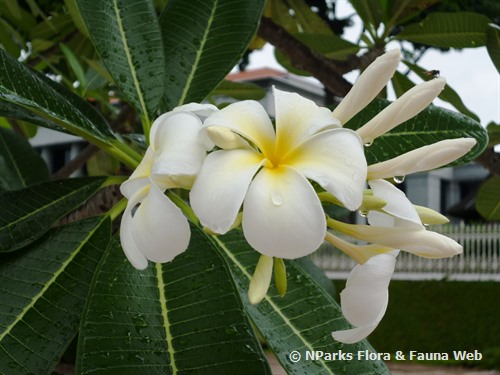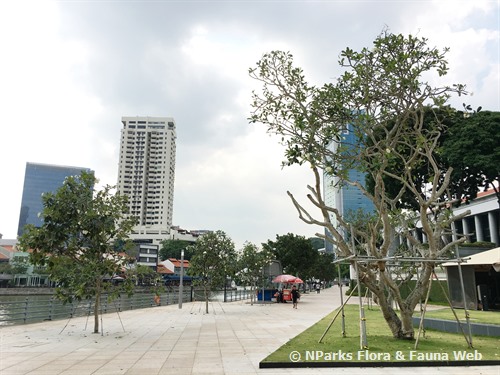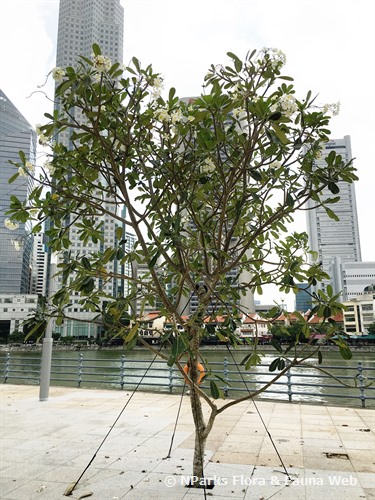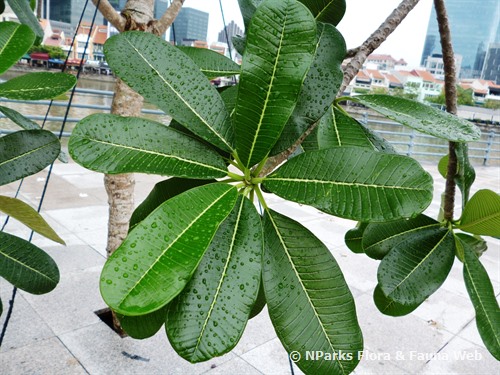
Back
Plumeria obtusa 'Singapore White'
| Family Name: | Apocynaceae |
| Common Name: | Frangipani, 鸡蛋花 |
Plumeria 'Singapore White' is a cultivar which can reach up to 12 m tall. It produces abundant white flowers throughout the year. It is widely cultivated for its ornamental and scented flowers.
Name
Classifications and Characteristics
| Plant Division | Angiosperms (Flowering Seed Plants) (Dicotyledon) |
|---|---|
| Plant Growth Form | Tree |
| Lifespan (in Singapore) | Perennial |
| Mode of Nutrition | Autotrophic |
| Plant Shape | Irregular |
| Maximum Height | 12 m |
Biogeography
| Native Distribution | Of horticultural origin |
|---|---|
| Preferred Climate Zone | Tropical |
| Local Conservation Status | Non-native (Horticultural / Cultivated Only) |
Description and Ethnobotany
| Growth Form | It is a tree which can reach up to 12 m tall with an irregular or rounded crown. All plant parts produce white sap when injured. |
|---|---|
| Foliage | The leaves are obovate, green and leathery. They tend to cluster at the end of the branches. |
| Flowers | Flowers are large, white with a small yellow center. This cultivar can produce very large flower clusters and has a strong floral scent. |
| Cultivation | Applying fertilizer with a high phosphate content (eg. NPK of 10-50-10) help to boost the plant growth. The plant also thrive in slightly acidic or neutral soil (pH 6.6 - 7.5) with high organic matter content (eg., compost, manure, leaf mold) and good drainage. Soil with coarse texture, such as sandy soil or sandy loam, is ideal for optimal plant growth. Growing the plant in waterlogged, poorly drained or compacted soil may cause the root to be prone to rot. |
| Etymology | The genus is named after French botanist, Charles Plumier, who contributed significantly to the botanical exploration of the Caribbean and Central America in the late 17th century. The common name, frangipani, is from the name of an Italian nobleman who produced a perfume with similar fragrance to plumeria flowers. |
| Ethnobotanical Uses | Others: In the Pacific islands region, women can discreetly declare their marital status by placing a Plumeria flower on the right ear if they are single or on the left if they are married. In Hawaii, the flowers are very popular and often used in floral leis. |
Landscaping Features
| Landscaping | It is often planted in gardens and parks as a ornamental plant. |
|---|---|
| Desirable Plant Features | Ornamental Flowers, Fragrant (Flowers) |
| Landscape Uses | General, Parks & Gardens, Container Planting, Small Gardens |
| Thematic Landscaping | Fragrant / Aromatherapy Garden |
| Usage Hazard - Cons | Irritant - Sap |
Fauna, Pollination and Dispersal
| Pollination Method(s) | Biotic (Fauna) |
|---|
Plant Care and Propagation
| Light Preference | Full Sun |
|---|---|
| Water Preference | Moderate Water |
| Plant Growth Rate | Moderate |
| Rootzone Tolerance | Well-Drained Soils, Fertile Loamy Soils, Drought Tolerant |
| Propagation Method | Stem Cutting |
| Propagation Method Remarks | Many methods of propagation are possible: herbaceous or woody stem cuttings, marcottings or air-layering. To propagate by stem cutting, cut a 15 -24 inch piece from the end of a non-flowering branch. Place the cutting in a dry, dark place for 4 - 7 days until a callus forms over the wound. Then, plant it in moist sand until it roots. This plant rarely produces seeds. |
Foliar
| Foliage Retention | Evergreen |
|---|---|
| Mature Foliage Colour(s) | Green |
| Foliar Type | Simple / Unifoliate |
| Foliar Attachment to Stem | Petiolate |
| Foliar Venation | Pinnate / Net |
| Foliar Margin | Entire |
| Leaf Area Index (LAI) for Green Plot Ratio | 2.5 (Tree - Open Canopy) |
Non - Foliar and Storage
| Trunk Type (Non Palm) | Woody |
|---|---|
| Root Type | Underground |
Floral (Angiosperm)
| Flower & Plant Sexuality | Bisexual Flowers |
| Flower Colour(s) | White |
|---|---|
| Flower Grouping | Cluster / Inflorescence |
| Flower Location | Terminal |
| Flower Symmetry | Radial |
| Flowering Period | Free-Flowering |
Image Repository
Others
| Master ID | 32841 |
|---|---|
| Species ID | 7255 |
| Flora Disclaimer | The information in this website has been compiled from reliable sources, such as reference works on medicinal plants. It is not a substitute for medical advice or treatment and NParks does not purport to provide any medical advice. Readers should always consult his/her physician before using or consuming a plant for medicinal purposes. |









